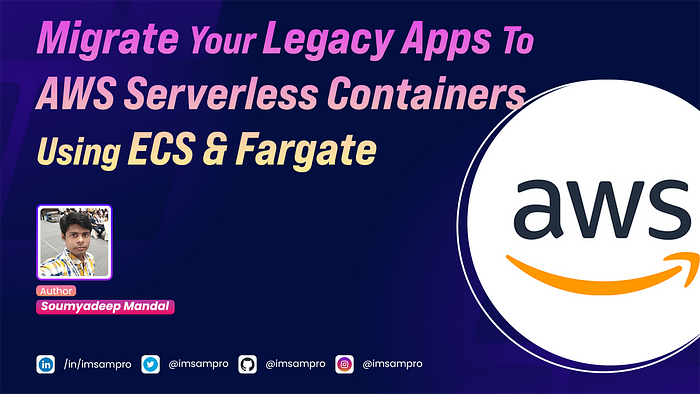Migrate Your Legacy Apps To AWS Serverless Containers Using ECS & Fargate

Many legacy applications are still running on traditional servers or virtual machines, which can be costly, inefficient, and hard to maintain. AWS has a great solution for migrating these legacy apps to the cloud with their Serverless Containers and Elastic Container Service.
In this article, I’ll talk about the benefits of using serverless containers and ECS and give a step-by-step guide for migrating your legacy applications to AWS’s serverless containers with ECS and Fargate.
What are Serverless Containers and ECS?
Serverless containers are containers that run on demand, without requiring any cluster or server management. They are ideal for applications that need to scale quickly and dynamically, without wasting resources or paying for idle capacity.
ECS is a service that runs containers on a cluster of servers, which can be either managed by AWS or by the developer. ECS allows you to choose between using EC2 instances or Fargate to run your containers, while Fargate is a serverless option that handles the infrastructure for you.
Why Migrate to Serverless Containers and ECS?
Migrating your legacy apps to serverless containers and ECS can result in significant cost savings, better performance, and increased agility. Some of the benefits include:
- No server administration: With Fargate, you don’t have to worry about provisioning, scaling, patching, or securing servers. You only pay for the resources you use, and you can easily adjust them as your needs change.
- Faster application deployment: With ECS, you can use familiar tools and workflows to build, test, and deploy your containerized applications. You can also integrate with other AWS services such as CodeDeploy, CodePipeline, CloudFormation, and Lambda.
- More efficient resource utilization: With serverless containers, you can run your applications with optimal CPU and memory allocation, without wasting resources or paying for idle capacity. You can also leverage features such as spot instances and auto-scaling to optimize your costs and performance.
- Improved scalability and reliability: With serverless containers and ECS, you can scale your applications up or down in seconds, based on demand. You can also take advantage of load balancing, health checks, service discovery, and fault tolerance to ensure high availability and resilience.
How to Migrate to Serverless Containers and ECS?
Migrating your legacy apps to serverless containers and ECS is not a one-size-fits-all process. It depends on factors such as the complexity of your application, the dependencies it has, the architecture it follows, and the migration strategy you choose.
However, here are some general steps that you can follow to migrate your legacy apps to serverless containers and ECS:
- Assess your application: Analyze your application’s requirements, dependencies, performance metrics, and architecture. Identify the components that can be migrated to serverless containers and ECS, and the ones that need to be refactored or rearchitected.
- Containerize your application: Convert your application into a container image that can run on any platform. You can use tools such as Docker or AWS App2Container to help you with this step. You can also use AWS ECR to store and manage your container images.
- Deploy your application: Create an ECS cluster and a Fargate task definition that specifies the container image, the resources, the network configuration, and the security settings for your application. You can use tools such as AWS Copilot or AWS CloudFormation to help you with this step. You can also use AWS ELB or AWS App Mesh to route traffic to your application.
- Test and monitor your application: Verify that your application is running correctly on serverless containers and ECS. You can use tools such as AWS CloudWatch or AWS X-Ray to monitor your application’s performance, health, and errors. You can also use tools such as AWS CloudTrail or AWS Config to audit your application’s activity and compliance.
Conclusion
Migrating your legacy apps to serverless containers on AWS can help you achieve significant cost savings, better performance, and increased agility. By using serverless containers and ECS, you can run your applications on demand, without having to worry about server administration. You can also leverage the power of AWS services and tools to build, test, deploy, scale, and monitor your applications.
If you are looking for a way to modernize your legacy applications and improve their performance, scalability, and cost-efficiency, you should consider migrating them to AWS serverless containers.
Are you curious about the details of this topic? Then you should check out my article on LinkedIn. It will show you how to leverage the power of serverless containers for your projects. You will be amazed by how easy and efficient they are. Don’t miss this opportunity to learn something new and exciting. Follow the link and share your feedback with me.
Thank you for reading!
